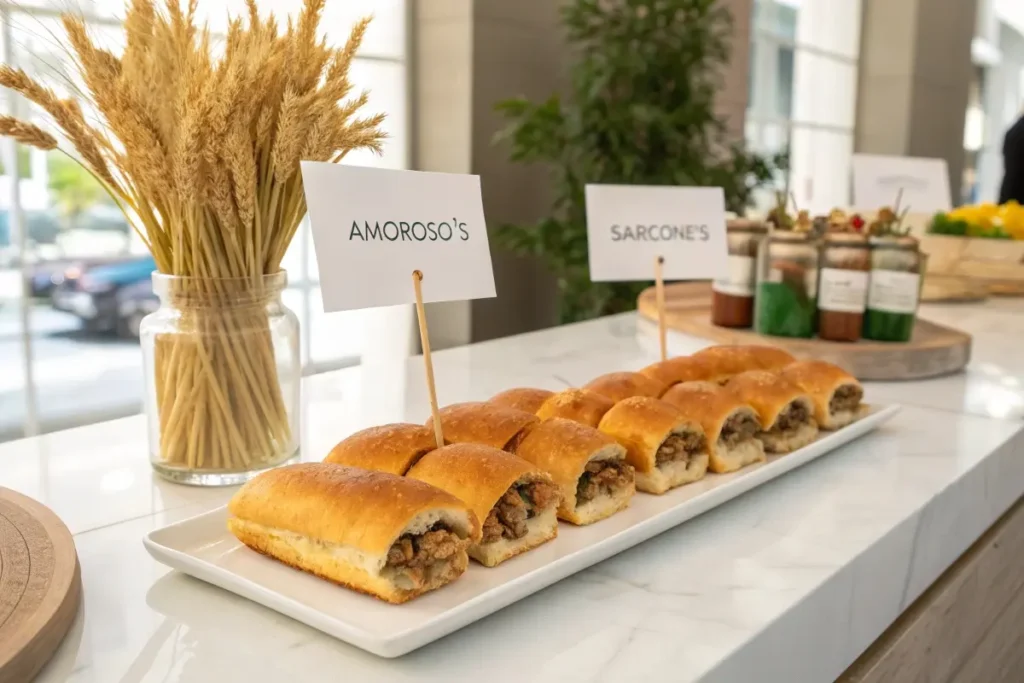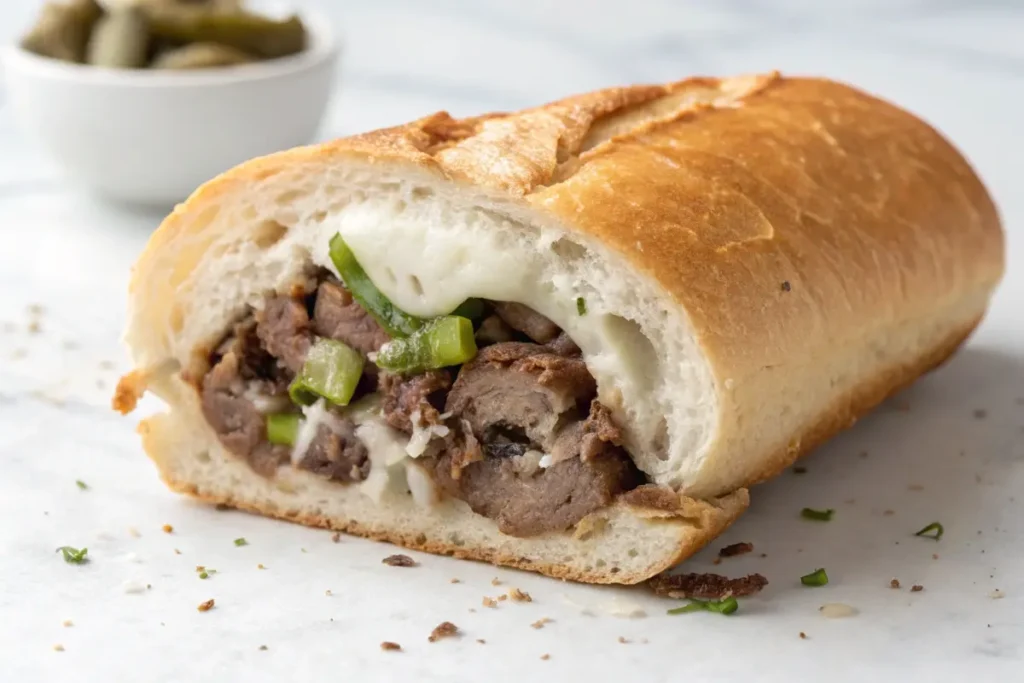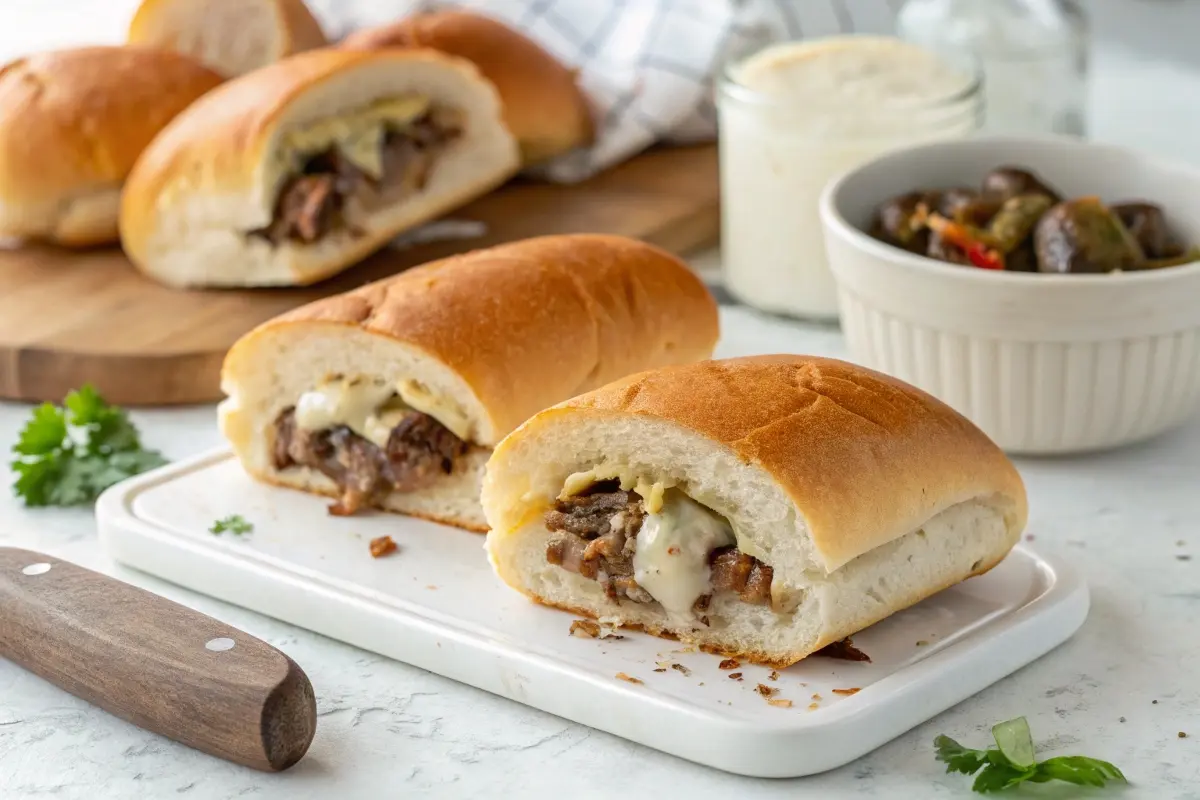The Philly cheesesteak is more than just a sandwich; in fact, it symbolizes culinary pride and tradition in Philadelphia. A key element of this dish is the rolls for Philly cheesesteaks, which hold together the juicy steak, melted cheese, and optional toppings. While the steak and cheese are often the stars, the roll quietly takes on the vital role of ensuring flavor and structure. Therefore, without the right roll, even the best steak and cheese combination can fall short.
Why Is the Roll So Important? In Philadelphia, the roll is more than a container. Instead, it’s a defining ingredient. The perfect roll must balance softness and firmness. For example, it should absorb the juices from the steak and cheese without becoming soggy. At the same time, it must hold up under the sandwich’s weight. Consequently, this balance has given rise to iconic bakeries that specialize in crafting the ideal cheesesteak rolls.
What to Expect In this Article, we’ll explore why the roll matters so much. Specifically, we’ll look at traditional options from famous bakeries like Amoroso’s and Sarcone’s. Additionally, we’ll discuss modern alternatives, such as gluten-free rolls. By the end, you’ll understand why the roll truly serves as the unsung hero of this classic dish.
The Role of the Roll in a Cheesesteak
The roll is not just functional; it’s a cornerstone of a Philly cheesesteak. The sandwich’s flavor harmony depends on the roll. It serves as the foundation for the steak, cheese, and toppings. A great roll can elevate the eating experience, making it essential for authenticity.
Why the Roll Matters
A cheesesteak roll has three critical roles:
- Structure: The roll holds juicy steak, melted cheese, and toppings like onions. A sturdy roll prevents leaks or spills.
- Texture: A good roll has a crusty exterior and a soft, absorbent interior. This contrast enhances every bite.
- Flavor Balance: The roll should have a mild flavor that complements the steak and cheese. Rolls that are too sweet or bland can ruin the sandwich.
Ideal Characteristics of a Cheesesteak Roll
- Length and Size: Rolls should be 8–10 inches long to hold a generous amount of steak and cheese. This ensures consistency in every bite.
- Absorbency: A great roll absorbs steak juices and melted cheese without becoming soggy.
- Crust and Crumb: The crust should provide slight resistance, while the interior (or crumb) must be light and airy. Dense or overly crusty rolls can make the sandwich heavy or messy.
How Rolls Influence the Experience
When you bite into a cheesesteak, the roll sets the stage. Its texture and flavor affect how the steak and cheese taste. A mediocre roll can make the sandwich feel lackluster. A high-quality roll enhances the overall flavor.
Traditional Rolls for Philly Cheesesteaks
Philadelphia’s reputation for cheesesteaks owes much to its long-standing tradition of using high-quality rolls. For decades, local bakeries have supplied cheesesteak shops with rolls that are both delicious and functional. These traditional rolls have become almost as iconic as the cheesesteaks themselves, creating a culinary standard that other cities strive to replicate.
The Amoroso’s Baking Company
Amoroso’s rolls, known for their slightly crusty exterior and soft interior, have become synonymous with cheesesteaks. These rolls absorb steak juices effectively without falling apart. Many iconic cheesesteak shops, such as Pat’s King of Steaks and Geno’s Steaks, use Amoroso’s rolls, which are also shipped nationwide.
Sarcone’s Bakery
Sarcone’s takes an artisanal approach, producing slightly denser rolls with a pronounced crust. This texture appeals to many cheesesteak enthusiasts and smaller, independent shops in Philadelphia.

Other Traditional Philly Rolls
While Amoroso’s and Sarcone’s dominate the cheesesteak roll conversation, several smaller bakeries contribute to Philly’s rich cheesesteak tradition. Examples include:
- Liscio’s Bakery: Known for its soft, flavorful rolls with a slight chew, Liscio’s is another local favorite.
- Conshohocken Italian Bakery: Often abbreviated as “Conshy,” this bakery produces rolls that are light yet sturdy, with a distinctive taste that complements cheesesteak fillings.
These bakeries, along with others in the region, highlight the variety and craftsmanship that define Philly cheesesteak rolls.
Why These Rolls Stand Out
The rolls from Philadelphia’s traditional bakeries share several common traits that make them ideal for cheesesteaks:
- Freshness: Philly bakeries pride themselves on delivering fresh rolls daily, ensuring the best texture and taste.
- Local Ingredients: Many bakeries use flour and other ingredients sourced from regional suppliers, giving their rolls a distinct flavor.
- Reputation: These bakeries have decades (or even centuries) of experience, refining their recipes to meet the exacting standards of cheesesteak lovers.
As we explore the anatomy of the perfect cheesesteak roll in the next section, you’ll see how these traditional rolls set the gold standard for this iconic sandwich.
The Anatomy of the Perfect Cheesesteak Roll
The Philly cheesesteak roll is not just a bread choice; it’s a finely tuned component of the sandwich. To qualify as “perfect,” a cheesesteak roll must meet specific criteria in terms of texture, flavor, size, and durability. These characteristics combine to ensure that the sandwich delivers the ideal experience, bite after bite.

Soft Interior, Slightly Crusty Exterior
The hallmark of a great cheesesteak roll is its texture. The interior should be soft, light, and slightly chewy to soak up the juices of the steak and melted cheese without becoming mushy. This absorbency is critical because a dry roll can leave the sandwich tasting bland, while an overly soft roll risks disintegrating.
On the outside, the roll should have a thin, slightly crusty shell. This provides a satisfying bite and helps keep the sandwich intact as you eat it. Unlike a baguette, which has a thick, crunchy crust, a cheesesteak roll’s crust is much subtler, ensuring it doesn’t overpower the fillings.
Size and Shape Considerations
The size and shape of a cheesesteak roll are just as important as its texture. Traditionally, Philly cheesesteak rolls are long and narrow, measuring around 8 to 10 inches. This length allows the sandwich to hold a generous portion of steak and cheese, ensuring that each bite is filled with flavor.
The roll’s diameter is also carefully considered. It should be wide enough to hold the fillings securely but not so large that it overshadows the steak and cheese. The goal is to achieve a balanced ratio of bread to filling, which is essential for the sandwich’s overall flavor.
How the Roll Enhances the Cheesesteak Experience
- Absorption: A perfect roll absorbs just the right amount of moisture from the steak, cheese, and optional toppings like sautéed onions or peppers. This enhances the flavor while preventing sogginess.
- Structural Integrity: Cheesesteaks are notoriously messy, but a good roll minimizes this by holding everything together. Even as you near the end of the sandwich, the roll should remain intact, without splitting or crumbling.
- Flavor Balance: The roll acts as a neutral canvas for the bold flavors of the steak and cheese. Its mild taste allows the fillings to shine while adding a subtle layer of flavor to each bite.
Customizing Rolls for Cheesesteaks
While traditional Philly rolls have a standard profile, some shops and home cooks like to customize their rolls to suit specific tastes:
- Toasted Rolls: Some cheesesteak enthusiasts prefer lightly toasting their rolls for added crunch.
- Seeded Rolls: Adding sesame seeds to the roll can introduce a nutty flavor and slightly different texture.
- Buttered Rolls: Spreading a thin layer of butter inside the roll and toasting it adds richness, especially for variations of cheesesteaks like the “cheesesteak hoagie.”
What Happens When the Roll is Wrong
Using the wrong type of roll can ruin the cheesesteak experience. Rolls that are too dense or dry can make the sandwich feel heavy, while those that are too soft or flimsy can collapse under the weight of the fillings. Non-traditional breads, such as ciabatta or sourdough, may bring interesting flavors but often fail to replicate the texture and functionality of a true Philly roll.
In short, the roll is not merely a vessel but a crucial element that defines the authenticity and quality of a Philly cheesesteak. Next, we’ll examine how some of Philly’s most iconic cheesesteak shops choose their rolls to create the ultimate sandwich experience.
Differences Between Philly Rolls and Non-Philly Rolls
Cheesesteak rolls from Philadelphia are distinct for their balance of softness and durability. Outside the city, bakeries may not have the same recipes, techniques, or even ingredients, leading to significant differences:
- New York Rolls: Often slightly denser and with a crustier exterior, New York-style rolls lack the soft interior that Philly rolls are known for.
- West Coast Rolls: Bakeries in California and other West Coast states sometimes use sweeter rolls, which can alter the flavor balance of the cheesesteak.
- Homemade Rolls: When made at home, cheesesteak rolls might rely on standard hoagie rolls or even baguettes, which rarely replicate the light, absorbent texture of Philly rolls.
Why Regional Bakeries Struggle to Replicate Philly Rolls
Philadelphia’s water supply is often cited as a key reason why its rolls are so distinctive. The mineral composition of the water affects the dough’s consistency and flavor during baking, making it hard for bakers elsewhere to replicate the exact texture and taste.
Additionally, traditional Philly bakeries like Amoroso’s and Sarcone’s use decades-old techniques and recipes, honed through generations of experience. This level of craftsmanship is difficult to reproduce in other regions.
Opinions on Non-Philly Rolls
While purists may scoff at cheesesteak rolls made outside of Philly, some chefs and food enthusiasts appreciate the opportunity to experiment. Rolls with unique textures or flavors, such as pretzel rolls or ciabatta, can add interesting twists to the classic sandwich. However, these variations are often considered “inspired by” rather than true Philly cheesesteaks.
Conclusion
The roll is the backbone of a true Philly cheesesteak. Its texture, flavor, and structure are just as important as the steak and cheese, making it a defining element of this iconic sandwich. Philadelphia’s traditional bakeries, with their time-honored recipes, have set a high bar for what a cheesesteak roll should be.
Whether you’re enjoying a cheesesteak in South Philly or recreating the experience at home, choosing the right roll is crucial to capturing the authentic taste and feel of this culinary masterpiece. From Amoroso’s to Sarcone’s, Philly’s rolls remain unmatched, a testament to the city’s rich food culture and passion for excellence.
FAQs
Who makes Philly cheesesteak egg rolls?
Philly cheesesteak egg rolls are made by various restaurants, food trucks, and home cooks who put a creative twist on the classic sandwich. Popular chains like Cheesecake Factory or specialty delis often feature this appetizer. Additionally, many caterers and food markets in Philadelphia offer cheesesteak egg rolls as a fun alternative to the traditional dish. You can also find recipes online to make them at home.
What is the secret ingredient in Philly cheesesteak?
The “secret ingredient” in a Philly cheesesteak often depends on who you ask! For many, it’s the type of roll used, like Amoroso’s, which enhances the sandwich’s flavor. Some believe the secret lies in the cheese choice, with Cheese Whiz being an iconic option. Others credit the seasoning blend used on the steak or the addition of sautéed onions for adding a unique touch. The simplicity of high-quality ingredients often makes the biggest difference.
What to eat with cheesesteak egg rolls?
Cheesesteak egg rolls pair well with fries, onion rings, coleslaw, or dipping sauces like cheese sauce, spicy aioli, or marinara.
What is the name of the bun on the Philly cheesesteak sandwich?
The traditional bun is called an Amoroso roll, known for its soft and chewy texture.
What’s the Best Roll Substitute for Home Chefs?
If Philly rolls aren’t available, the best substitutes are Italian hoagie rolls with a soft interior and light crust. Avoid rolls that are too dense, crusty, or sweet, as they can alter the cheesesteak’s flavor and texture.
Are Gluten-Free Rolls a Good Option for Cheesesteaks?
Gluten-free rolls are a viable alternative for those with dietary restrictions. While they lack the exact texture of traditional Philly rolls, some brands offer soft, sturdy options that work well for cheesesteaks. Experimenting with different gluten-free brands can help find the best match.
How Do Cheesesteak Shops Keep Rolls Fresh?
Philadelphia cheesesteak shops prioritize freshness by receiving daily deliveries from local bakeries. Rolls are stored in cool, dry conditions to maintain their texture and are typically used within 24 hours to ensure peak quality.
What’s the difference between a cheesesteak and a Philly cheesesteak?
While “cheesesteak” and “Philly cheesesteak” are often used interchangeably, the term “Philly cheesesteak” specifically refers to the sandwich’s origins in Philadelphia. Authentic Philly cheesesteaks use thinly sliced ribeye steak, melted cheese (like Whiz, provolone, or American), and a soft hoagie roll. Cheesesteaks made outside of Philly might deviate from these traditional elements, using different meats, cheeses, or breads, making them less authentic to the Philly style.
